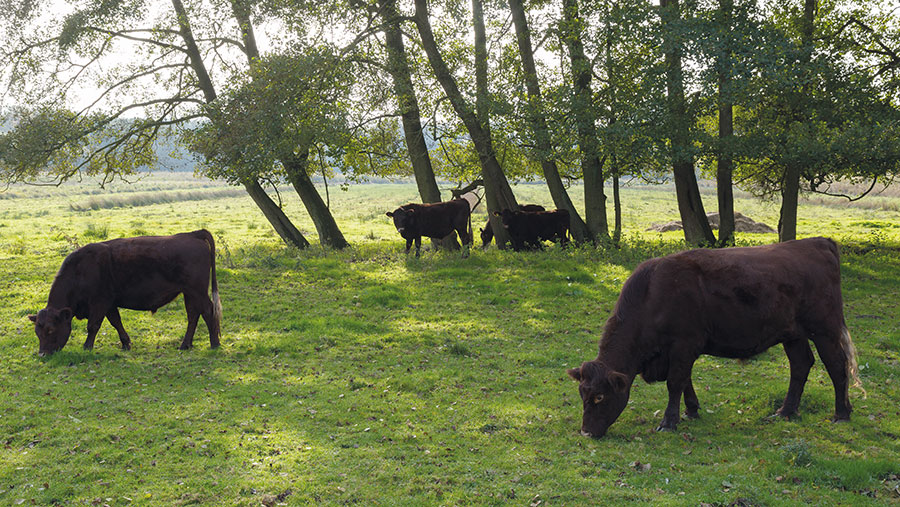What benefits do trees offer to livestock systems?
 © MAG/Judith Tooth
© MAG/Judith Tooth Trees offer animals huge benefits, according to Lindsay Whistance, senior livestock researcher at the Organic Research Centre.
She sets out the value of silvopasture to livestock systems.
See also: Defra paves the way for more agroforestry in England
1. Shelter
Trees buffer the landscape, elevating ground temperatures in winter by up to 6C under tree canopies, increasing lying comfort and feeding opportunities.
Rain and high wind speeds are becoming more frequent and cold, rain and wind all lead to poorer animal welfare.
For example, for every 1C drop below a beef animal’s lower critical temperature [temperature below which a resting animal must increase its metabolic rate to meet environmental demands for heat], there is a 2% increase in energy requirement.
Lambs have very few resources at birth – and, without shelter, they can lose up to 10C of body heat in the first half-hour of life.
2. Shade
Conversely, in summer, areas under trees may be the only green parts of the field.
According to Met Office forecasts, by 2050, every second summer will be like the one we experienced in 2018 [the joint-hottest summer on record]
During heat stress, blood is removed from non-vital systems such as the reproductive and digestive tracts to the skin to help the cooling process.
As much as half the blood in the digestive tract can be diverted, making the gut membrane very permeable to toxins and potentially leading to rumen acidosis.
Dairy cows without access to shade are also significantly more likely to get mastitis, says Dr Whistance.
Other research shows the quality of colostrum falls in cows facing heat stress in late gestation, and their heifer calves go on to have depressed milk yields in their first two lactations.
An alternative heat stress model – the equivalent temperature index for cattle, which uses a wider range of parameters such as skin temperature.
It suggests cattle begin to suffer heat stress at 18C, experience moderate heat stress at 20C, severe heat stress at 25C and, at 31C, are in a state of emergency.
3. Reducing stress
Social behaviour is more cohesive in silvo- pasture systems.
For example, social licking accounts for 78% of social interaction in silvopasture, compared with 48% in open pasture.
Social licking is beneficial because it reduces stress by lowering heart rate.
Using trees to rub away old hair, fleece, dead skin, parasites such as ticks, and seeds that can penetrate the skin, also reduces heart rate. In addition, a healthy coat and skin are barriers to disease.
4. Nutrition
Leaf nutrition from trees is highly comparable to grasses and forbs in terms of fat, carbohydrate and protein content.
Mineral content in browse can be high – willow is a very good source of zinc, for example.
Trees also contain condensed tannins, which promote the delivery of high-quality rumen bypass protein to the small intestine, reducing the amount of methane produced.
Leaves can be browsed directly or animals can browse cut branches before clearing (see “Palatability and resilience of native tree species”).
Leaves can also be preserved as tree fodder, as hay or silage.
Palatability and resilience of native tree species |
|
|
Palatability* |
Tree species |
|
1 |
Aspen, willow |
|
2 |
Ash, rowan |
|
3 |
Hazel, oak |
|
4 |
Scots pine, juniper, holly |
|
5 |
Birch, hawthorn |
|
6 |
Beech |
|
7 |
Alder |
|
*1 = most palatable. In lowland woodlands aspen may be in palatability class 3. |
|
What is silvopasture?
Silvopasture is the integration of trees with livestock that results in direct economic and/or ecological gains to the farming system.
It includes forest grazing, wood pasture, orchard grazing and individual trees, spaced or in rows, within areas grazed or cut for forage.
It can involve different combinations of trees integrated into forage systems and combined with livestock production, or livestock integrated into woodland areas to benefit trees and animals.
Lindsay Whistance was speaking at Groundswell, which took place on 23-24 June at Lannock Manor Farm, Hitchin, north Hertfordshire.
